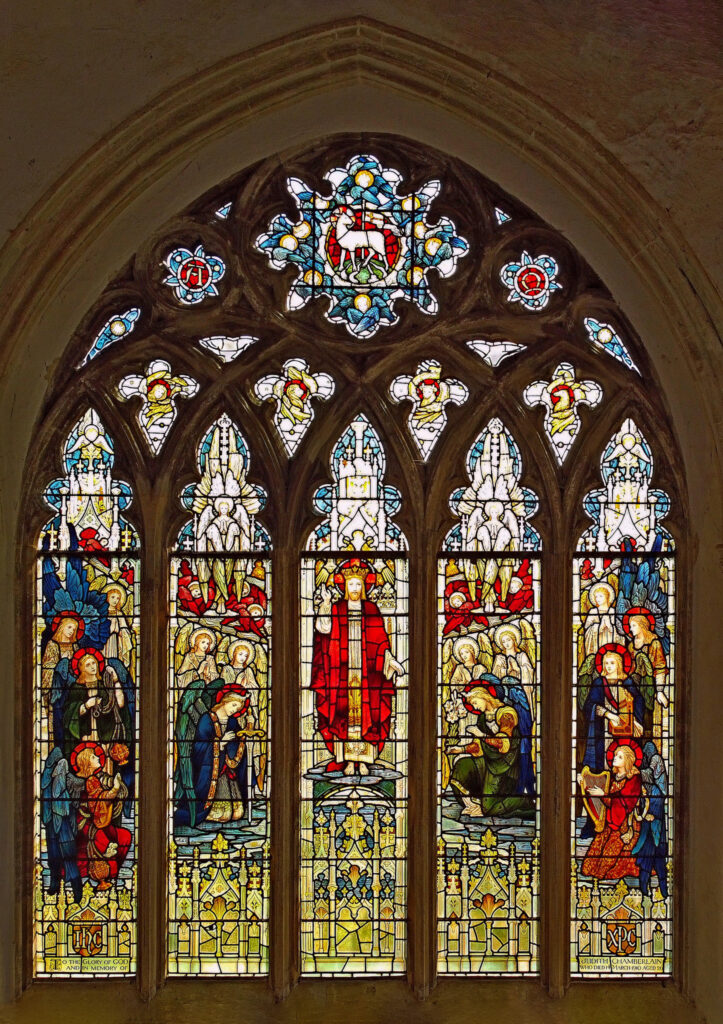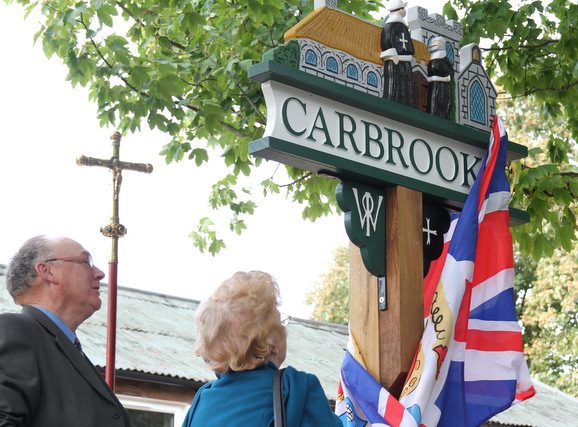
For over a hundred years now, St Peter and St Paul Church in Carbrooke has been blessed with a splendid stained glass East Window, produced and installed by the highly-regarded James Powell and Sons of Whitefriars, London. It is dedicated both to a young woman called Judith Chamberlain who died aged 26 in 1910 and “to the glory of God”. Undoubtedly the beautiful design— in which Jesus Christ, flanked by the Archangels Michael and Gabriel, reveals his wounds to the congregation below— has enhanced the worship of generations of churchgoers. The East Window may have become very familiar to modern day worshippers, but none were able to explain the history of the window or of the family behind its installation.
The quest to discover more about Judith Chamberlain and her family for a long time drew many blanks. The parish registers and census returns revealed there were no Chamberlains resident in Carbrooke in the late 19th and early 20th centuries. Assuming that Chamberlain was in fact Judith’s married name, a search was made of the marriage records, but no Judith married a Mr Chamberlain in Norfolk around this time. No Judith at all was born in Norfolk in 1884, her presumed year of birth. There was not even a record of her death in 1910 in the English listings.
A breakthrough was made at the Norfolk County Record Office. For any change to be made to the fabric of a church, the diocese has to agree to a faculty. Fortunately, the faculty document granting Carbrooke parish church permission to change its East Window still exists. Dated 9th June 1911, it states
“it is proposed to glaze with coloured glass the east window in memory of the daughter of Edward Charles Harrison Bennet Esq. Of Rokeles Hall, Watton”.
As is sometimes the case in local history research, when one vital piece of evidence is discovered, a gate opens allowing for an exhilarating scamper down a new path. A whole cache of newly discovered information has now emerged about the family of Judith Harrison Chamberlain (nee Bennet).
Her father Edward C.H. Bennet was born in about 1856 in London. He married Constance Gage Blake (born in about 1860 in Rougham, Suffolk) in 1882. At the time, Edward was a farmer living in Copdock near Ipswich. By the time Judith Harrison Bennet was born in 1884, the family were living at Nowton, a village south of Bury St Edmunds. Another daughter Bridget May Bennet was born in 1890, by which time the family had re-located to Hall Farm in Garboldisham.
The 1890s must have been a very prosperous time for the Bennets because by
1901 the family had moved to the grand residence of Rokeles Hall, Watton Green. In the census Edward Bennet referred to himself as a “retired farmer”, even though he was only 45. The family could afford a governess for their younger daughter Bridget as well as three servants. At the time of the census, Judith (aged 17) was staying with her grandmother Anne E. Bennet at
“Friedenfels” on Upper Maze Hill in St Leonards-on-Sea in Sussex. It is not known how long Judith lived at Rokeles Hall.
The trail picks up once more on 27th April 1909, when Judith married Thomas
Arthur Chamberlain in Kensington, London. Thomas, known in his family as Arthur was born in 1880 in Great Hormead, Hertfordshire, the son of Rev James S. Chamberlain, a Church of England clergyman , originally from Rufford in Lancashire. Eight years earlier, Thomas was living with his father at The Rectory in Staplehurst, Kent. It is not clear why Judith broke with tradition and married away from her home parish. However, the event was recorded in the diaries of Arthur’s grandmother, who wrote:
I was home in Norwood before the end of the month and in time for Tuesday 27th April, which was Arthur’s Wedding Day. They were married at St. Mary Abbot’s, Kensington and all my children, except Edmund were there, The reception afterwards was at Mrs Blake’s.
The diaries reveal that Judith (referred to as “Judy”) and Arthur made several visits to Norwood from the Spring of 1907 onwards and that Arthur had spent time working in Ireland, returning to London in July 1907.
The marriage was very brief and tragic. Within a year of marrying Thomas, Judith had died. A further year on, plans for her memorial window at Carbrooke were coming to fruition.
The newly married Chamberlains had moved to a small Irish village called Belvelly, near Cobh (then called Queenstown) in County Cork. Thomas, now aged 29, was a land agent. Their daughter Betty Judith Chamberlain was born in Belvelly on 11th February 1910.
There was no time for Betty to be baptised before the sad death of Judith Chamberlain in Belvelly on 14th March 1910, aged 26. Arthur’s grandmother wrote in her diary:
It was on the 11th that a little girl was born to Judy and Arthur, but only to hear a month later, on March 14th, that Judy had passed away at 7.30 in the morning .
Records indicate that Judith was buried just 4 days later on 18th March 1910.
Astonishingly, it would seem that Judith’s body was hastily transported by boat and by train across from Ireland to Carbrooke. Judith is buried close to the south wall of the church. She rests under a now well-weathered lead-lettered, three-stepped Latin Cross. The inscription reads: “Blessed are the dead which die in the Lord”.
It may have been because his eldest daughter died so far from home that her father Edward Bennet wished to immortalise Judith’s name in a stained glass window back in Carbrooke. At a vestry meeting held at the school in Carbrooke on 18th April 1911, attended by the then Vicar, Rev Frederick E. Perrin and his churchwardens Alfred J. Johnson and K. Murrell,
“it was unanimously decided that the offer of E.C.H. Bennet Esq. to glaze with coloured glass the East Window of the church be gratefully accepted”.
Edward Bennet did have one particular concern. He was aware that about 45 years before, a wealthy landowner and benefactor called Richard Dewing had paid for some small segments of stained glass to be placed in the existing East Window. It was felt these would not be in keeping with the new design and would need to be removed. Edward Bennet did not want to offend the Dewing family. However, in a letter sent to the Vicar from his home, Rougham Hall, near Bury St Edmunds, the late Richard Dewing’s nephew Edward Dewing (a retired Colonel formerly with the Royal Engineers) gave the family’s formal consent and approval.
And so, at a reported cost of £300 (the equivalent today would be approximately £25,000) Carbrooke’s new East Window was designed, crafted and installed. Further generosity from Edward Bennet led to the additional improvement of a solid oak rededos, a screen below the window and behind the altar, at a cost of £232, in 1913. And what became of Judith’s family? Her father Edward Bennet died in 1925. Her mother Constance lived until 1937. Both are buried near the north-east corner of Carbrooke churchyard, although their grave is sadly now overgrown, broken and illegible. Judith’s sister Bridget May Bennet never married and lived at 39 Welbeck Avenue, Hove, Sussex for many years until her death in 1961 aged 72. Judith’s widowed husband Arthur Chamberlain married Frances Penny on 12th May 1914. They had two sons and a daughter. Arthur died in Bournemouth in 1962. Judith’s own daughter Betty Judith Chamberlain died in Ascot, Berkshire in 1977.
It is hoped that any living relatives of Judith Chamberlain (nee Bennet) are aware of the magnificent East Window which her father left at the church of St Peter and St Paul in memory of the tragically short life of his beloved elder daughter and will visit the church to share the beautiful legacy Edward Bennet bequeathed to the villagers of Carbrooke.
Mark Ward 22/06/11
Updated 26.10.25
Diary extracts courtesy of Mark Hutchinson.
